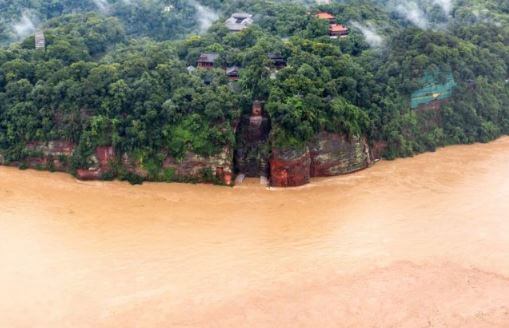
Abaddon
 26. 04. 2024
26. 04. 2024



 09. 10. 2020
09. 10. 2020

The largest Buddha statue on our planet, located in the southwestern province of China, was partially flooded. The rising water level flooded the fingers of the huge Leshan Buddha in Sichuan Province in southwest China. This iconic statue last wet its feet in 1949. According to Smithsonian magazine, Lešanský Buddha is "considered the largest stone Buddha in the world" and adds that it is "by far the tallest surviving pre-modern statue."
The concerns are twofold. It is primarily from the water that touches about 71 m high Buddha. However, The Independent also remarks: "Local legend has it that if the feet of a statue carved into the mountainside in the eighth century get wet, the capital of Sichuan province, Chengdu, will be flooded."
In addition to religious aspects, the flood can also affect the overall stability of the Buddha. Sandbags were placed around the statue to hold the rising surface. However, this measure has proved ineffective. A drainage system has been installed inside the statue itself to handle such natural events, but Mother Nature is proving to be a strong adversary.

Lešan giant Buddha surrounded by flood waters after heavy and continuous rains in the southwestern Chinese province of Sichuan. (Photo STR / AFP) / China OUT (Photo STR / AFP via Getty Images)
Two people can stand in the massive Buddha's ears, which, unlike the rest of the statue, are made of clay-covered wood. The head itself is 14,6 m high and 10 m wide. No less than 100 monks suddenly sat on the sacred feet. In the past centuries, a wooden gazebo was built around Lešanský Buddha, reaching a height of 13 floors. The Smithsonian writes that "the building was destroyed at the end of the Ming Dynasty." This place, popular with pilgrims, is listed as a UNESCO World Heritage Site. In addition, the statue is carved into the cliff, which makes it a faithful part of the landscape.
The Buddha is believed to represent Maitreya, an ancient disciple of the Buddha who was allegedly worshiped between the 4th and 7th centuries. The magazine goes on to say, "According to tradition, Maitreya is considered to be the" future Buddha "who will one day descend to Earth to preach a new dharma or law."
At the place where Maitreya sits, three rivers meet. The man behind the complicated creation of the statue was the monk Hai Tong, who tried to calm the turbulent waters and provide a safer path for people sailing on ships. His motives were supernatural and practical. The ship accidents in Leshan were more than a disaster for the locals.
The Travel China guide writes: “People attributed the disaster to the presence of the water spirit. So Hai Tong decided to carve a statue by the river, thinking that the Buddha would have the spirit of water under control. "
For Hai Tong, the matter did not end well, but his legacy is still alive. He has been trying to raise funds for his ambitious project for several decades. Corruption in the government drove him to the point of removing his own eye to scare money-hungry officials. He himself lived to see the completion of only one half of the statue. The construction lasted a total of 90 years, the statue is approximately 1200 or 1300 years old, depending on the source.
The citizens of Leshan and - as stated in the prophecy - Chengdu had to be saved from the floods that are spreading through central and southwestern China. Heavy rains are behind the current crisis.
The New York Times reports that, according to Secretary-General Zhou Xuewen of Flood Protection, "at least 63 million people have been affected and 54 homes have been destroyed." More than 000 people have already died or are still missing.
The Times mentions that the Yangtze River and the Yellow River recorded record levels. The latter has reached "the highest level since 1997" in Shenxi Province. The level of the Three Gorges Dam in Hubei Province "has reached its highest level since it began holding water in 2003."
Not only giant Buddhas, inhabitants and animals, but also cars are in danger. The Independent reports that "21 vehicles parked in the square fell into a hole after a road collapsed beneath them at night" in I-pin, Sichuan Province. China's economy has lost about $ 26 billion. The imposing Lešan Buddha enriches the province with its presence, but continued downpours can endanger the statue. Smithsonian magazine states: "Without the loss of corrosive rainwater and air pollution, the erosion of the sculpture can continue."
Whether we believe or not the stories of the supernatural consequences of the water touching the Buddha, it is an important reminder of the power of nature. Let's hope that this incredible statue, with everything it represents, conceals a much greater resilience, regardless of the floods.
Bracelet with lava stones and a motif of Buddha or God's hand. You can choose either black or turquoise.

Buddha bracelet made of lava stones